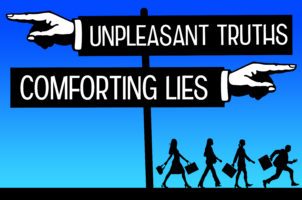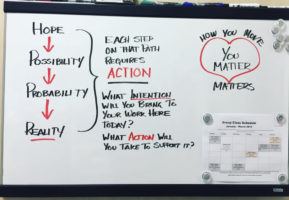Six Steps to Success for your New Year’s Resolutions
I’m not a huge fan of New Year’s resolutions. Typically born after a few weeks of excess, they come soaring in on the wings of sparkling visions of the future. If only we were: richer, thinner, fitter, healthier, more disciplined, more relaxed, better parents, better friends, more supportive partners… then, our lives would be better. WE would be better. Right? Maybe. Or maybe not. According to U.S. News & World Report, about 80% of New Year’s resolutions fail; most of them by mid-February. Does that mean that any bold decision to make change is doomed to fail? No. The key to success lies in the way we go about making change, and how we support ourselves in the transition. As a new decade dawns, I thought I’d share six steps to success for your New Year’s Resolutions 2020.
Let’s start with the idea that we are perfect as we are. We are alive and that is a wonderful thing. Sometimes we have good years, sometimes we have bad ones. Sometimes we love what we’re doing, and sometimes not so much. Some years life is hard, sometimes it seems to flow. Through it all, we are all unique and complex individuals, worthy of love and connection. So if you have no desire for change, then bravo baby! Go on living life exactly as you are!
Even with all that love and perfect imperfection, there are sometimes still parts of ourselves we’d like to amplify, soften, or even change. Making moves to realize our full potential can be a powerful thing. Why not find a way to support a natural evolution of the qualities we desire? I’m not an expert on New Year’s resolutions. But with over 25 years as a Pilates, dance and movement teacher, I’ve coached a lot of people through some big changes. Here are a few things I’ve learned along the way:

Photo by Ian Schneider on Unsplash
Step 1. Acknowledge & Celebrate Your Journey So Far
In a desire to move forward, we sometimes forget to acknowledge and celebrate the important experiences of our past. What trials have we been through? Have we learned any lessons? What were the milestones along the way – the little victories on the way to the big ones? Take a good look at the important moments in your life in the last year. Take stock and make a list. Looking back at tough stuff may help re-frame things in terms of lessons learned; instead of whatever challenge you may have felt at the time. Seeing a list of successes you may have forgotten about can be a powerful reminder of the work you’ve already done, and a motivator for more. Pat yourself on the back for a job well done.
I read a brilliant article last week entitled “End Your Year Intentionally” that is well worth a read. The author asks some important questions that may help ground your New Year’s resolutions in light of what has come before. And it might remind you that you’re probably doing better than you realize.
Step 2. Understand the “Why” of your Resolution
Among the most common themes to New Year’s resolutions are: health, weight loss, fitness, career advancement, and financial freedom. It’s easy to say, “I’m going get fit,” or “I’m going to be the top XYZ at my firm this year.” Those are just words. For your best chance at success, your resolution has to have a deeper meaning for you. Why do you want to get fit? On achieving your goal, what will become possible for you that is not possible for you now? Why is that important to you? How will life be different for you after you’ve achieved that goal? How will you know when you’re done?
A while back, I gave a keynote speech at a conference for fitness professionals in Ottawa. I spoke to the group about how creating connections with our clients has a real impact on the outcomes that we’re able to achieve with them. Part of that process is beginning to understand the “why” of the work that we do as fitness professionals, and the “why” of the people who choose to work with us. Embarking on any kind of change, if we know the “why” behind it, then we can more easily create the strategies that will support us in achieving success. Here’s a link to an article I wrote on the subject: Creating Connections: Inspiring Change

Photo by Annie Spratt on Unsplash
Step 3. Be Specific
Once you’ve figured out why you want to make a change, it’s easier to break down the exact steps you need to take to get there. If you’re looking to get fit – understand what fit means to you. Are you concerned about specific aspects of your health? Do you just want to look better in your clothes? Do you want to be able to effortlessly play with your kids? Would you prefer to wake up with fewer aches and pains? Do you want to play a sport? Do you want a social fitness experience? Each one of these things might require a different action, and a different choice around the kind of fitness training you might seek out.
Be very clear about exactly what you want to better engineer your path to getting there. And if you’re not sure – try a few different pathways to narrow things down! There are no missteps – only steps to better clarity.
Step 4. Anticipate the Road Blocks
Making major change is one place where Nike’s old adage, “Just Do It,” won’t do it. Reaching for change requires that we do something different; that we change our habits, and consciously choose to act in a new way. Making bold new choices is easy when we’re full of the fire and promise of a new idea. When we’re tired, or stressed, or bored though, old patterns of behaviour and belief can overpower our best intentions. We skip the workout, we eat the doughnut, we put that charge on the credit card, we begin to doubt ourselves.
Take a look at the inner and outer landscape of your life. What are the pitfalls of making this resolution likely to be? Are there emotional patterns or mental habits that might get in your own way? Are the people around you supportive of the change? Where will you find support? Are there costs associated with what you’re trying to do? How will you fund it? If cost is an issue, are there affordable ways to do it? How will you manage your stress levels so that the transition isn’t just an added item on your to-do list? What are the specific strategies that will support you through the inevitable tough times? Provide yourself with little rewards along the way, to celebrate your progress. Find ways to support success and make it as easy as possible to do the right thing.
 Step 5. Get Real
Step 5. Get Real
Be honest and compassionate with yourself about where you are today. If you haven’t gone for a run in 20 years, it’s pretty unrealistic to expect to run a marathon in 6 months, no matter how determined you are. You may have a memory of being a badass on the track, but your body has 20 years of lived experience doing something else entirely. Whatever your goal, get real about where you’re starting from and give yourself time. Demanding too much too soon can lead to false starts, inconsistency and blows to morale. If you’re undertaking a new physical goal, start slowly and give your body the opportunity to remember how good it feels to move; rather than punishing yourself for years of inactivity. As you begin to move more, your body will crave more. Be kind to yourself!
Step 6. Cultivate Consistency
Change isn’t created by the things we do sometimes. Change comes as a result of the things you do consistently. Pure and simple, success comes down to whether you did, or whether you didn’t. When you think about working toward your goal, how does your body feel? Is the goal a heavy thing, a weight on your shoulders? Or does the thought of achieving your goal get you excited, help you find motivation and give you energy to proceed? If you have to fight intense internal resistance all the time, or if the body feels dense, heavy and hard , ask yourself why you’re feeling this way. Sometimes these feelings are simply a natural resistance to change, which wears off after a few weeks. But if the resistance persists? Check in with yourself. Maybe this change isn’t the right change right now.
Consistency is easy when the change is in integrity with the rest of your life. Is your resolution in harmony with who you are, and how you want to live your life? If the change you want to make doesn’t line up somehow with your beliefs, your values and your life goals, you are likely to experience, at the very least, a difficulty being consistent with it.
 Hope —-> Possibility —–> Probability —–> Reality
Hope —-> Possibility —–> Probability —–> Reality
Intention is the seed, but the path from resolution to real life requires action. Understand what you want. Make an intention each day to take some small action to support your choice. When the actions in the direction you want to go start to outweigh your old patterns, you’ll be on your way to seeing real change. It’s snowball effect! You may find things move slowly at first – but as your early actions start to bear fruit, the next steps get easier and easier to take.
With some awareness and introspection, we can connect to our most meaningful needs and goals, and forge pathways to the kind of life we most want to live. Enjoy this year, whichever way your path takes you! I have faith that you’ll find the way.
What is your best experience with a New Year’s resolution? Share your thoughts in the comments below. It’s always wonderful to hear how someone else has overcome obstacles to achieve new possibilities.
About Susannah Steers
 Susannah is a Pilates and Integrated Movement Specialist, and owner of Moving Spirit. Through movement teaching, speaking, and facilitating workshops, she supports people in creating movement practices that promote fitness from the inside out. She loves building community, and forging multi-disciplinary connections. Susannah co-hosts The Small Conversations for a Better World podcast – an interview based podcast dedicated to promoting the kind of conversations about health that can spark change in individuals, families, communities and and the world.
Susannah is a Pilates and Integrated Movement Specialist, and owner of Moving Spirit. Through movement teaching, speaking, and facilitating workshops, she supports people in creating movement practices that promote fitness from the inside out. She loves building community, and forging multi-disciplinary connections. Susannah co-hosts The Small Conversations for a Better World podcast – an interview based podcast dedicated to promoting the kind of conversations about health that can spark change in individuals, families, communities and and the world.
